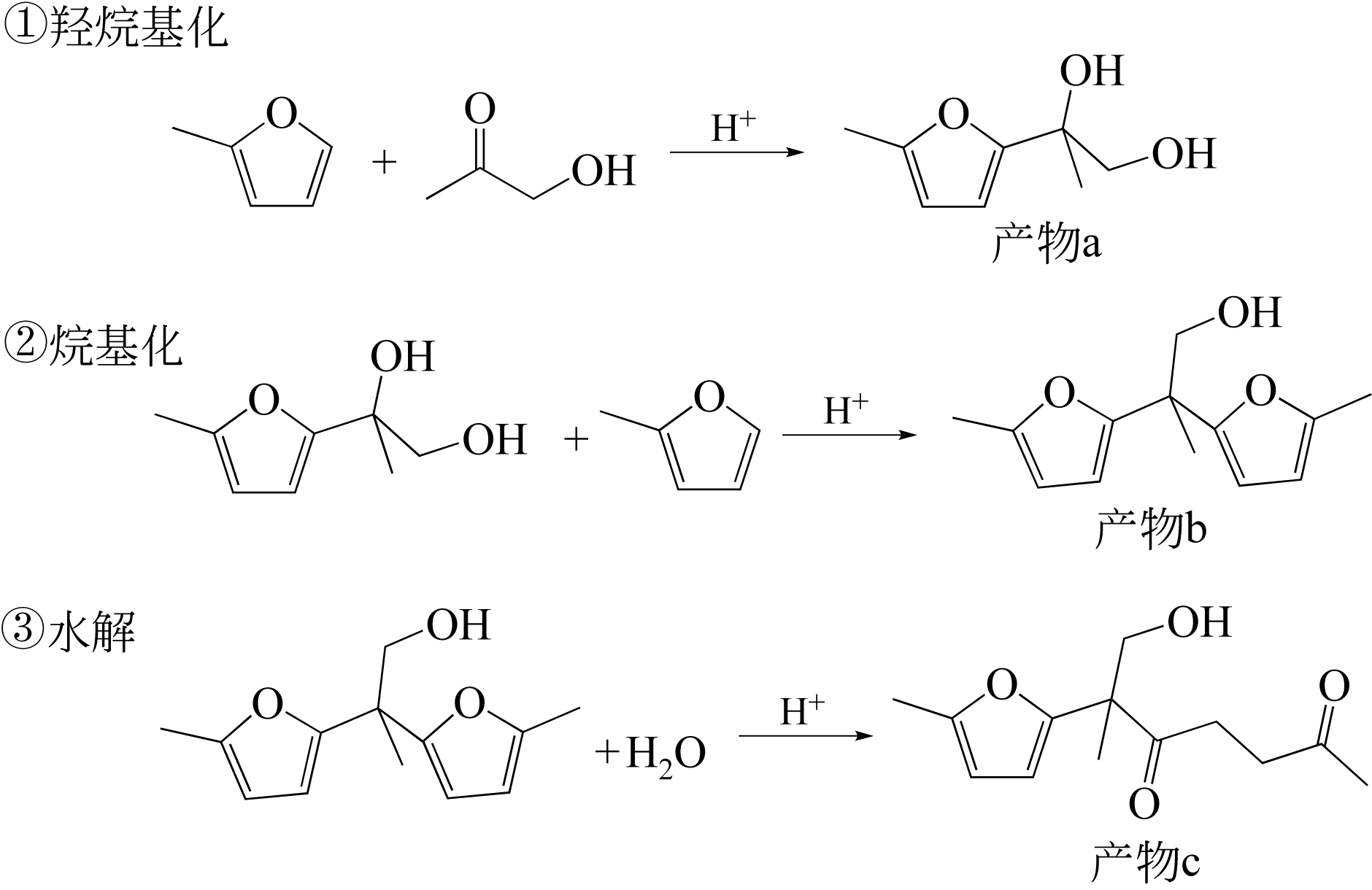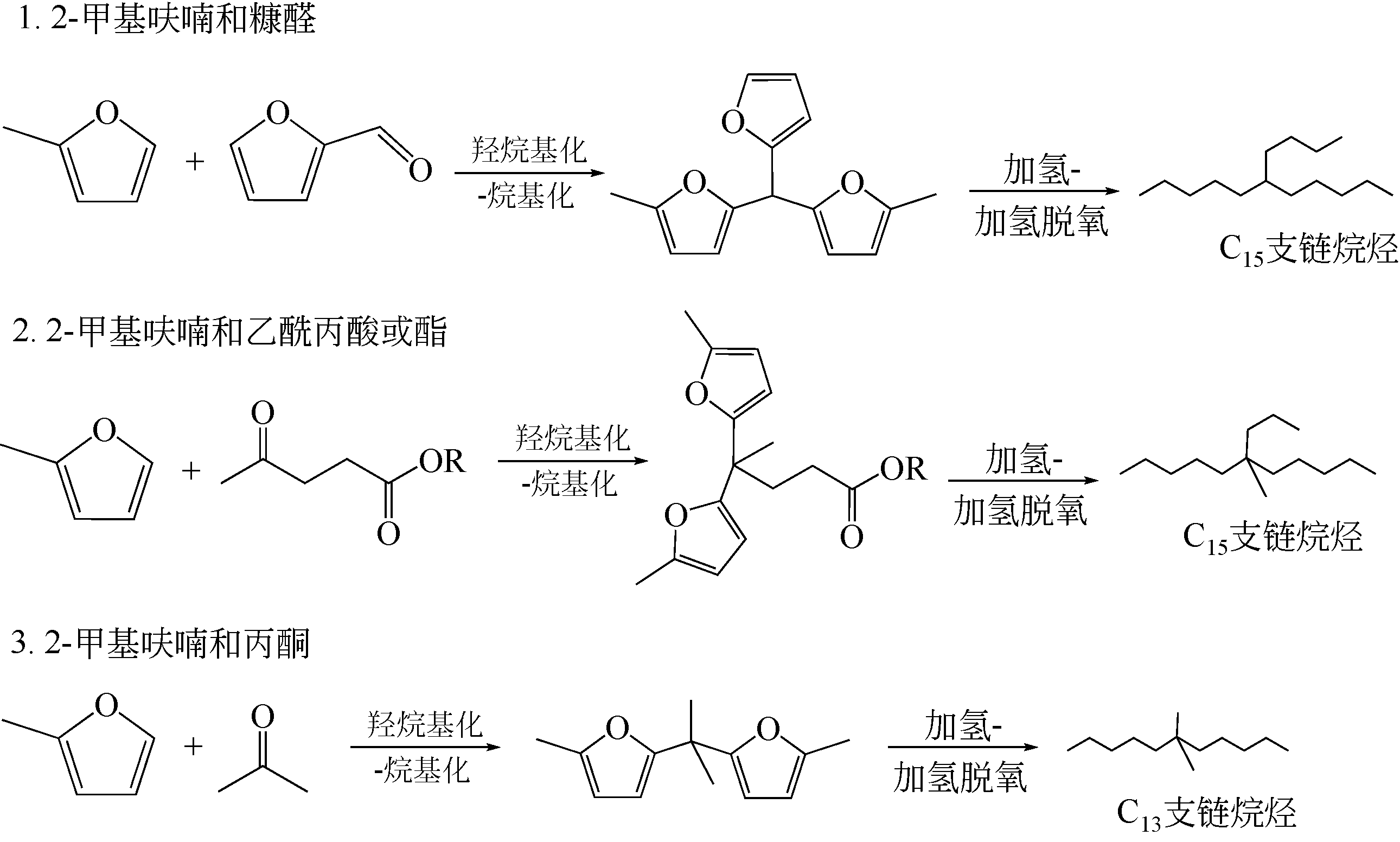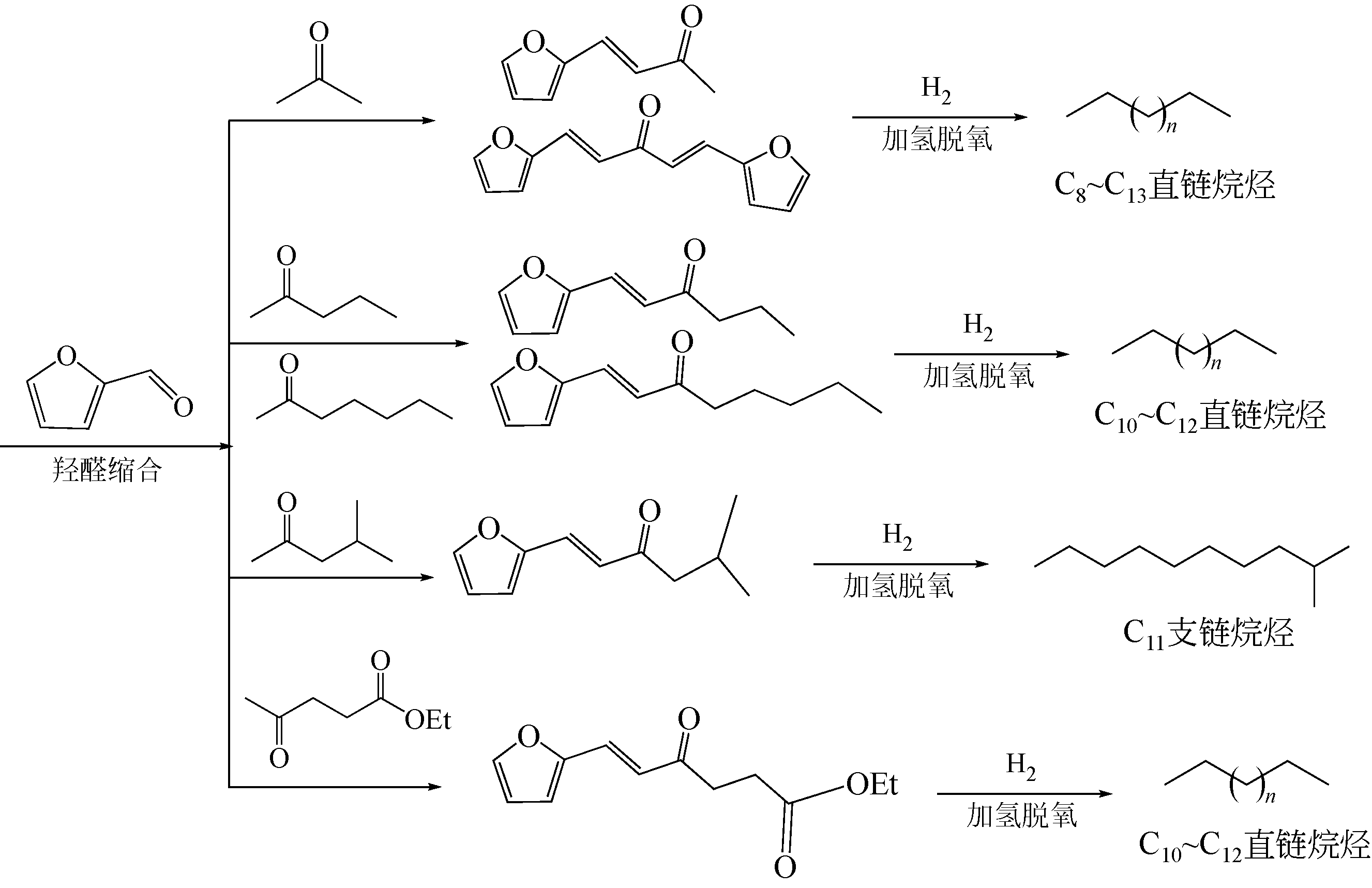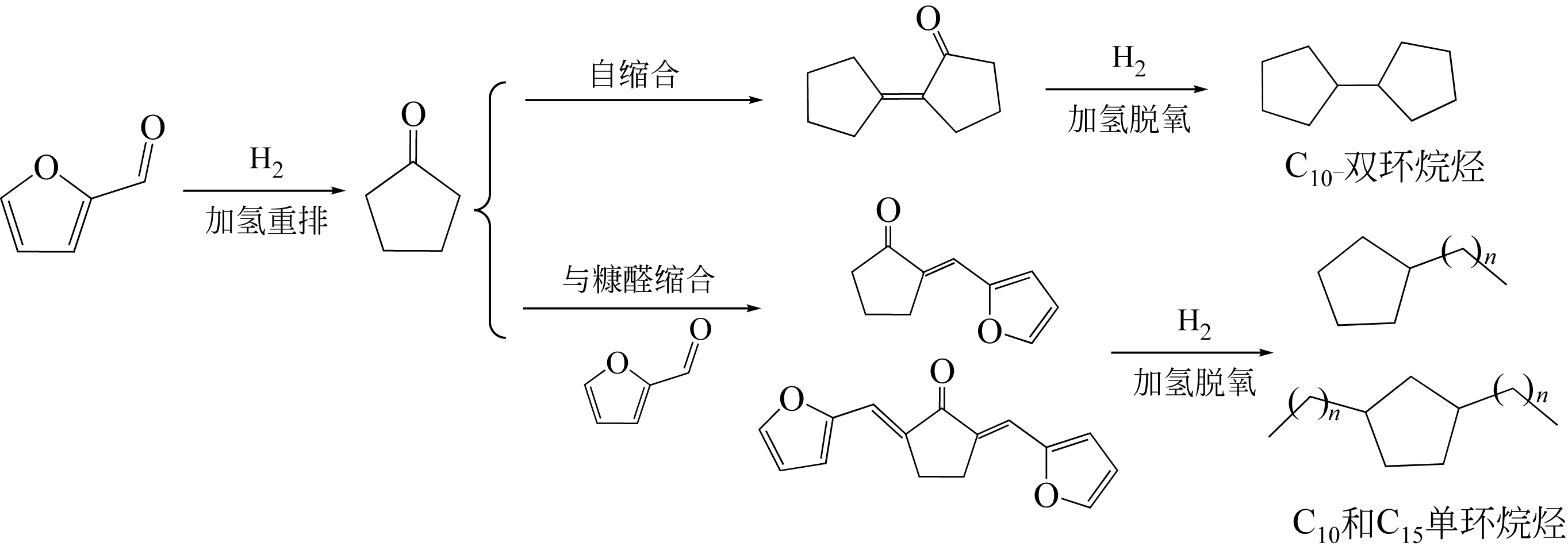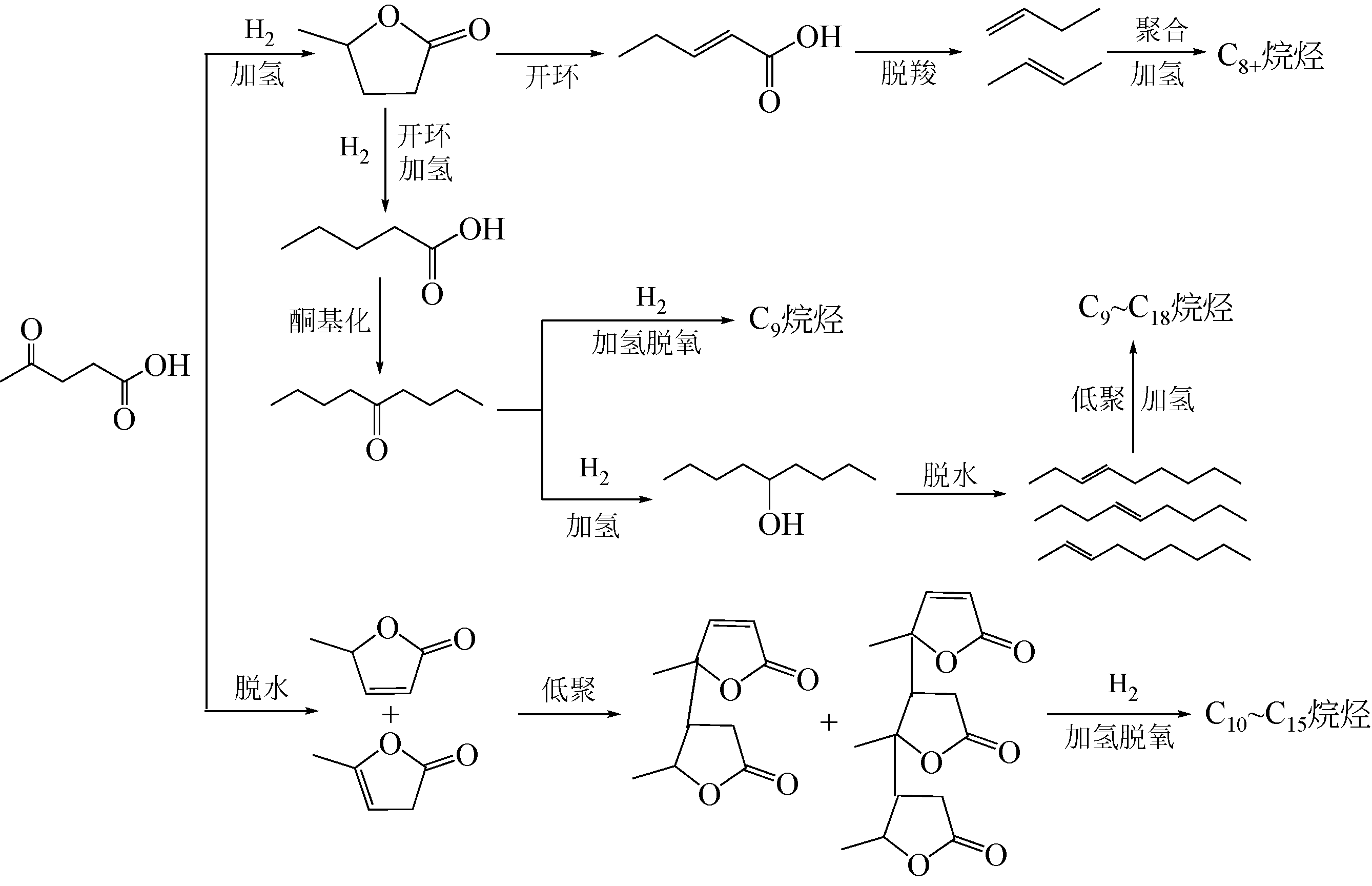Chemical Industry and Engineering Progress ›› 2019, Vol. 38 ›› Issue (03): 1269-1282.DOI: 10.16085/j.issn.1000-6613.2018-0984
Previous Articles Next Articles
Progress in aviation biofuel technology by catalysis synthesis of platform molecules from lignocelluloses depolymerization
Lungang CHEN( ),Xinghua ZHANG,Qi ZHANG,Chenguang WANG,Longlong MA(
),Xinghua ZHANG,Qi ZHANG,Chenguang WANG,Longlong MA( )
)
- Guangzhou Institute of Energy Conversion, Chinese Academy of Sciences
-
Received:2018-05-14Revised:2018-06-05Online:2019-03-05Published:2019-03-05 -
Contact:Longlong MA
木质纤维素解聚平台分子催化合成航油技术的进展
- 中国科学院广州能源研究所,中国科学院可再生能源重点实验室,广东省新能源和可再生能源重点实验室,广东 广州 510640
-
通讯作者:马隆龙 -
作者简介:陈伦刚 (1981—),男,副研究员,硕士生导师,主要从事生物质催化转化制备烃类燃料的研究。E-mail:chenlg1981@ms.giec.ac.cn 。|马隆龙,研究员,博士生导师,所长,研究领域为生物质能源。E-mail:mall@ms.giec.ac.cn 。 -
基金资助:国家自然科学基金(21878290);广东省自然科学基金(2017A030313073);中国科学院洁净能源先导科技专项(XDA 21060102)
CLC Number:
Cite this article
Lungang CHEN,Xinghua ZHANG,Qi ZHANG,Chenguang WANG,Longlong MA. Progress in aviation biofuel technology by catalysis synthesis of platform molecules from lignocelluloses depolymerization[J]. Chemical Industry and Engineering Progress, 2019, 38(03): 1269-1282.
陈伦刚,张兴华,张琦,王晨光,马隆龙. 木质纤维素解聚平台分子催化合成航油技术的进展[J]. 化工进展, 2019, 38(03): 1269-1282.
share this article
Add to citation manager EndNote|Ris|BibTeX
URL: https://hgjz.cip.com.cn/EN/10.16085/j.issn.1000-6613.2018-0984
| 序号 | 技术路径 | 平台分子原料要求 | 技术路径优势 | 技术路径缺点 |
|---|---|---|---|---|
| 1 | 羟烷基化途径 | 纯度、浓度和杂质要求高 | 碳利用率高、目标烃类产物选择性高、燃料分子结构调控性强 | 工艺流程长、受限于来源于半纤维素的2-甲基糠醛、平台分子分离提纯导致能耗高、损耗大 |
| 2 | 羟醛缩合途径 | 纯度、浓度和杂质要求不高 | 碳利用率高、目标烃类产物选择性高、燃料分子结构调控性强、纤维素和半纤维素解聚的平台分子可同步利用 | 工艺流程较长、酸碱消耗大 |
| 3 | 水相重整途径 | 纯度、浓度和杂质要求不高 | 工艺流程短、纤维素和半纤维素来的平台分子可同步利用 | 碳利用率低、目标烃类产物选择性低、燃料分子结构调控性差 |
| 4 | 烯烃聚合途径 | 纯度、浓度和杂质要求高 | 烯烃聚合后的加氢反应条件温和易实现 | 工艺流程长、碳利用率较低、目标烃类产物选择性较低、燃料分子结构调控性较差、对烯烃的纯度要求高 |
| 序号 | 技术路径 | 平台分子原料要求 | 技术路径优势 | 技术路径缺点 |
|---|---|---|---|---|
| 1 | 羟烷基化途径 | 纯度、浓度和杂质要求高 | 碳利用率高、目标烃类产物选择性高、燃料分子结构调控性强 | 工艺流程长、受限于来源于半纤维素的2-甲基糠醛、平台分子分离提纯导致能耗高、损耗大 |
| 2 | 羟醛缩合途径 | 纯度、浓度和杂质要求不高 | 碳利用率高、目标烃类产物选择性高、燃料分子结构调控性强、纤维素和半纤维素解聚的平台分子可同步利用 | 工艺流程较长、酸碱消耗大 |
| 3 | 水相重整途径 | 纯度、浓度和杂质要求不高 | 工艺流程短、纤维素和半纤维素来的平台分子可同步利用 | 碳利用率低、目标烃类产物选择性低、燃料分子结构调控性差 |
| 4 | 烯烃聚合途径 | 纯度、浓度和杂质要求高 | 烯烃聚合后的加氢反应条件温和易实现 | 工艺流程长、碳利用率较低、目标烃类产物选择性较低、燃料分子结构调控性较差、对烯烃的纯度要求高 |
| 序号 | 主要成分 | 分子结构 | 碳数 | 相对丰度/% |
|---|---|---|---|---|
| 1 | 3-甲基庚烷 |  | 8 | 4.03 |
| 2 | 正辛烷 |  | 8 | 4.64 |
| 3 | 4-甲基辛烷 |  | 9 | 3.49 |
| 4 | 3-甲基辛烷 |  | 9 | 3.59 |
| 5 | 正壬烷 |  | 9 | 3.41 |
| 6 | 4-甲基壬烷 |  | 10 | 2.81 |
| 7 | 正癸烷 |  | 10 | 2.10 |
| 8 | 丁基-环己烷 |  | 10 | 0.71 |
| 9 | 5-甲基癸烷 |  | 11 | 2.64 |
| 10 | 4-甲基癸烷 |  | 11 | 2.74 |
| 11 | 正十一烷 |  | 11 | 1.97 |
| 12 | 5-甲基十一烷 |  | 12 | 20.04 |
| 13 | 正十二烷 |  | 12 | 3.03 |
| 14 | 正十三烷 |  | 13 | 6.58 |
| 15 | 5-甲基十二烷 |  | 13 | 24.19 |
| 16 | 1,1,3,5-四甲基环己烷 |  | 10 | 1.28 |
| 17 | 1,2-二丁基环戊烷 |  | 14 | 1.53 |
| 18 | 6-甲基十三烷 |  | 14 | 8.11 |
| 19 | 1-甲基-4-异丙基环己烷 |  | 10 | 2.86 |
| 20 | 2,7-二甲基萘 |  | 12 | 0.15 |
| 21 | 1-甲基-3-异丙基环己烷 |  | 10 | 0.09 |
| 序号 | 主要成分 | 分子结构 | 碳数 | 相对丰度/% |
|---|---|---|---|---|
| 1 | 3-甲基庚烷 |  | 8 | 4.03 |
| 2 | 正辛烷 |  | 8 | 4.64 |
| 3 | 4-甲基辛烷 |  | 9 | 3.49 |
| 4 | 3-甲基辛烷 |  | 9 | 3.59 |
| 5 | 正壬烷 |  | 9 | 3.41 |
| 6 | 4-甲基壬烷 |  | 10 | 2.81 |
| 7 | 正癸烷 |  | 10 | 2.10 |
| 8 | 丁基-环己烷 |  | 10 | 0.71 |
| 9 | 5-甲基癸烷 |  | 11 | 2.64 |
| 10 | 4-甲基癸烷 |  | 11 | 2.74 |
| 11 | 正十一烷 |  | 11 | 1.97 |
| 12 | 5-甲基十一烷 |  | 12 | 20.04 |
| 13 | 正十二烷 |  | 12 | 3.03 |
| 14 | 正十三烷 |  | 13 | 6.58 |
| 15 | 5-甲基十二烷 |  | 13 | 24.19 |
| 16 | 1,1,3,5-四甲基环己烷 |  | 10 | 1.28 |
| 17 | 1,2-二丁基环戊烷 |  | 14 | 1.53 |
| 18 | 6-甲基十三烷 |  | 14 | 8.11 |
| 19 | 1-甲基-4-异丙基环己烷 |  | 10 | 2.86 |
| 20 | 2,7-二甲基萘 |  | 12 | 0.15 |
| 21 | 1-甲基-3-异丙基环己烷 |  | 10 | 0.09 |
| 样品 | 各元素质量分数/% | 热值 /MJ·kg-1 | ||
|---|---|---|---|---|
| C | H | O | ||
| 玉米秸秆 | 45.76% | 6.22% | 47.79% | 16.1 |
| 缩合产物 | 62.53% | 4.75% | 32.72% | 30.8 |
| 加氢后的 | 59.66% | 8.73% | 31.43% | 32.7 |
| 加氢脱氧后的 | 81.39% | 14.07% | 4.09% | 41.7 |
| 加氢精制后的 | 84.15% | 15.24% | 0.37% | 45.5 |
| 样品 | 各元素质量分数/% | 热值 /MJ·kg-1 | ||
|---|---|---|---|---|
| C | H | O | ||
| 玉米秸秆 | 45.76% | 6.22% | 47.79% | 16.1 |
| 缩合产物 | 62.53% | 4.75% | 32.72% | 30.8 |
| 加氢后的 | 59.66% | 8.73% | 31.43% | 32.7 |
| 加氢脱氧后的 | 81.39% | 14.07% | 4.09% | 41.7 |
| 加氢精制后的 | 84.15% | 15.24% | 0.37% | 45.5 |
| 1 | 欧阳四余, 徐琼, 伏再辉, 等 . 生物质转化制5-羟甲基糠醛的酸催化研究新进展[J]. 化工进展, 2014, 33(5): 1077-1085. |
| OUYANG S Y , XU Q , FU Z H , et al . Advances in production of 5-hydroxymethylfurfural from biomass by acid catalysis[J]. Chemical Industry and Engineering Progress, 2014, 33(5): 1077-1085. | |
| 2 | 高美香, 刘宗章, 张敏华 . 生物质转化制糠醛工艺的研究进展[J]. 化工进展, 2013, 32(4): 878-884. |
| GAO M X , LIU Z Z , ZHANG M H . Progress in the production of furfural from biomass[J]. Chemical Industry and Engineering Progress, 2013, 32(4): 878-884. | |
| 3 | 邓理, 廖兵, 郭庆祥 . 纤维素选择性催化转化为重要平台化合物的研究进展[J]. 化工进展, 2013, 32(2): 245-254. |
| DENG L , LIAO B , GUO Q X . Recent progress in selective catalytic conversion of cellulose into key platform molecules[J]. Chemical Industry and Engineering Progress, 2013, 32(2): 245-254. | |
| 4 | 张挺, 常春 . 生物质制备乙酰丙酸酯类转化路径的研究进展[J]. 化工进展, 2012, 31(6): 1224-1230. |
| ZHANG T , CHANG C . Advances in the route of levulinate esters from biomass[J]. Chemical Industry and Engineering Progress , 2012, 31(6): 1224-1230. | |
| 5 | 彭红, 刘玉环, 张锦胜, 等 . 生物质生产乙酰丙酸研究进展[J]. 化工进展, 2009, 28(12): 2237-2241. |
| PENG H , LIU Y H , ZHANG J S , et al . Progress in production of levulinic acid from biomass[J]. Chemical Industry and Engineering Progress, 2009, 28(12): 2237-2241. | |
| 6 | 张家仁, 邓甜音, 刘海超 . 油脂和木质纤维素催化转化制备生物液体燃料[J]. 化学进展, 2013, 25: 192-208. |
| ZHANG J R , DENG T Y , LIU H C . Catalytic production of liquid biofuels from triglyceride feedstocks and lignocellulose[J]. Progress in Chemistry, 2013, 25: 192-208. | |
| 7 | 陈凯, 钱璟, 杨智渊, 等 . 航空生物燃料生产工艺研究进展[J]. 石油化工, 2012, 41: 974-978. |
| CHEN K , QIAN J , YANG Z Y , et al . Advances in aviation biofuel production technology[J]. Petrochemical Technology, 2012, 41: 974-978. | |
| 8 | 聂红, 孟祥堃, 张哲民, 等 . 适应多种原料的生物航煤生产技术的开发[J]. 中国科学(化学), 2014, 44: 46-54. |
| LIE H, MENG X K , ZHANG Z M , et al . Development of technology for producing bio-jet fuel from several feedstocks[J]. Scientia Sinica Chimica, 2014, 44: 46-54. | |
| 9 | COLLARD F X , BLIN J . A review on pyrolysis of biomass constituents: mechanisms and composition of the products obtained from the conversion of cellulose, hemicelluloses and lignin[J]. Energy Reviews, 2014, 38: 594-608. |
| 10 | HUBER G W , CHHEDA J N , BARRETT C J , et al . Production of liquid alkanes by aqueous-phase processing of biomass-derived carbohydrates[J]. Science, 2005, 308: 1446-1450. |
| 11 | CORMA A , DE LA TORRE O , RENZ M , et al . Production of high-quality diesel from biomass waste products[J]. Angewandte Chemie:International Edition, 2011, 50: 2375-2378. |
| 12 | 朱晨杰, 杜风光, 应汉杰, 等 . 木质纤维素基平台化合物催化转化制备液体燃料及燃料添加剂[J]. 化工学报, 2015, 66(8): 2784-2794. |
| ZHU C J , TU F G , YING H J , et al . Catalytic production of liquid hydrocarbon fuels and fuel additives from lignocellulosic platform molecules[J]. CIESC Journal , 2015, 66(8): 2784-2794. | |
| 13 | 余强, 庄新姝, 袁振宏, 等 . 木质纤维素类生物质制取燃料及化学品的研究进展[J]. 化工进展, 2012, 31(4): 784-791. |
| YU Q , ZHANG X S , YUAN Z H , et al . Research progress on fuel and chemicals production from lignocellulose biomass[J]. Chemical Industry and Engineering Progress, 2012, 31(4): 784-791. | |
| 14 | BARRETT C J , CHHEDA J N , HUBER G W , et al . Single-reactor process for sequential aldol-condensation and hydrogenation of biomass-derived compounds in water[J]. Applied Catalysis B, 2006, 66: 111-118. |
| 15 | CHHEDA J N , DUMESIC J A . An overview of dehydration, aldol-condensation and hydrogenation processes for production of liquid alkanes from biomass-derived carbohydrates[J]. Catalysis Today, 2007, 123: 59-70. |
| 16 | CHHEDA J N , HUBER G W , DUMESIC J A . Liquid-phase catalytic processing of biomass-derived oxygenated hydrocarbons to fuels and chemicals[J]. Angewandte Chemie: International Edition, 2007, 46: 7164-7183. |
| 17 | HUBER G W , CORMA A . Synergies between bio- and oil refineries for the production of fuels from biomass[J]. Angewandte Chemie: International Edition, 2007, 46: 7184-7201. |
| 18 | BOND J Q , ALONSO D M , WANG D , et al . Integrated catalytic conversion of γ-valerolactone to liquid alkenes for transportation fuels[J]. Science, 2010, 327: 1110-1114. |
| 19 | CORMA A , DE LA TORRE O , RENZ M . High-quality diesel from hexose-and pentose-derived biomass platform molecules[J]. ChemSusChem, 2011, 4: 1574-1577. |
| 20 | LI G , LI N , WANG Z , et al . Synthesis of high-quality diesel with furfural and 2-methylfuran from hemicellulose[J]. ChemSusChem, 2012, 5: 1958-1966. |
| 21 | RICCI M , PEREGO C . Diesel fuel from biomass[J]. Catalysis Science & Technology, 2012, 2: 1776-1786. |
| 22 | WILSON K , LEE A F . Rational design of heterogeneous catalysts for biodiesel synthesis[J]. Catalysis Science & Technology, 2012, 2: 884-897. |
| 23 | CLIMENT M J , CORMA A , IBORRA S . Conversion of biomass platform molecules into fuel additives and liquid hydrocarbon fuels[J]. Green Chemistry, 2013, 16: 516-547. |
| 24 | HAN J , SEN S M, ALONSO D M , et al . A strategy for the simultaneous catalytic conversion of hemicellulose and cellulose from lignocellulosic biomass to liquid transportation fuels[J]. Green Chemistry, 2013, 16: 653-661. |
| 25 | LI G , LI N , LI S , et al . Synthesis of renewable diesel with hydroxyacetone and 2-methyl-furan[J]. Chemical Communications, 2013, 49: 5727-5729. |
| 26 | LI G , LI N , YANG J , et al . Synthesis of renewable diesel with the 2-methylfuran, butanal and acetone derived from lignocellulose[J]. Bioresource Technology, 2013, 134: 66-72. |
| 27 | LIU D , CHEN E , XU Y . Diesel and alkane fuels from biomass by organocatalysis and metal-acid tandem catalysis[J]. ChemSusChem, 2013,6: 2236-2239. |
| 28 | PUPOVAC K , PALKOVITS R . Cu/MgAl2O4 as bifunctional catalyst for aldol condensation of 5-hydroxymethylfurfural and selective transfer hydrogenation[J]. ChemSusChem, 2013, 6: 2103-2110. |
| 29 | SUTTON A D , WALDIE F D , WU R , et al . The hydrodeoxygenation of bioderived furans into alkanes[J]. Nature Chemistry, 2013,5: 428-432. |
| 30 | YANG J , LI N , LI G , et al . Solvent-free synthesis of C10 and C11 branched alkanes from furfural and methyl isobutyl ketone[J]. ChemSusChem, 2013, 6: 1149-1152. |
| 31 | LI G , LI N , YANG J , et al . Synthesis of renewable diesel range alkanes by hydrodeoxygenation of furans over Ni/H β under mild conditions[J]. Green Chemistry, 2014, 16: 594-599. |
| 32 | SERRANO-RUIZ J C , LUQUE R , SEPULVEDA-ESCRIBANO A . Transformations of biomass-derived platform molecules: from high added-value chemicals to fuels via aqueous-phase processing[J]. Chemical Society Reviews, 2011, 40: 5266-5281. |
| 33 | CORMA A T , RENZ M . Production of high quality diesel from cellulose and hemicellulose by the sylvan process: catalysts and process variables[J]. Energy & Environmental Science, 2012, 5: 6328-6344. |
| 34 | LI S , LI N , LI G , et al . Synthesis of diesel range alkanes with 2-methylfuran and mesityl oxide from lignocellulose[J]. Catalysis Today, 2014,234: 91-99. |
| 35 | XU G-Q , LI Q , FENG J-G , et al . Direct α-alkylation of ketones with alcohols in water[J]. ChemSusChem, 2014, 7: 105-109. |
| 36 | LI G Y , LI N , WANG X K , et al . Synthesis of diesel or jet fuel range cycloalkanes with 2-methylfuran and cyclopentanone from lignocellulose[J]. Energy Fuels, 2014, 28: 5112-5118. |
| 37 | HUBER G W , DUMESIC J A . An overview of aqueous-phase catalytic processes for production of hydrogen and alkanes in a biorefinery[J]. Catalysis Today, 2006, 111: 119-132. |
| 38 | WEST R M , LIU Z Y , PETER M , et al . Carbon-carbon bond formation for biomass-derived furfurals and ketones by aldol condensation in a biphasic system[J]. Journal of Molecular Catalysis A: Chemical, 2008, 296: 18-27. |
| 39 | OLCAY H , SUBRAHMANYAM A V , XING R , et al . Production of renewable petroleum refinery diesel and jet fuel feedstocks from hemicellulose sugar streams[J]. Energy & Environmental Science, 2013, 6: 205-216. |
| 40 | WEST R M , LIU Z Y , PETER M , et al . Liquid alkanes with targeted molecular weights from biomass-derived carbohydrates[J]. ChemSusChem, 2008, 1: 417-424. |
| 41 | J-P LANGE , HEIDE E , BUIJTENEN J , et al . Furfural——a promising platform for lignocellulosic biofuels[J]. ChemSusChem, 2012,5: 150-166. |
| 42 | HRONEC M , FULAJTAROVA K , LIPTAJ T , et al . Cyclopentanone: a raw material for production of C15 and C17 fuel precursors[J]. Biomass Bioenergy, 2014, 63: 291-299. |
| 43 | FABA L , DIAZ E , ORDONEZ S . Aqueous-phase furfural-acetone aldol condensation over basic mixed oxides[J]. Applied Catalysis B, 2012, 113/114: 201-211. |
| 44 | FABA L , DIAZ E , ORDONEZ S . Improvement on the catalytic performance of MgZr mixed oxides for furfural acetone aldol condensation by supporting on mesoporous carbons[J]. ChemSusChem, 2013, 6: 463-473. |
| 45 | 黄晓明, 章青, 刘琪英, 等 . MgO/NaY 催化糠醛和丙酮合成航油中间体的性能研究[J]. 燃料化学学报, 2012, 40: 973-978. |
| HANG X M , ZHANG Q , LIU Q Y , et al . Production of jet fuel inter2018-0984tes from furfural and acetone by aldol condensation over MgO/NaY[J]. Journal of Fuel Chemistry and Technology, 2012, 40: 973-978. | |
| 46 | XU W , LIU X , REN J , et al . A novel mesoporous Pd/cobalt aluminate bifunctional catalyst for aldol condensation and following hydrogenation[J]. Catalysis Communications, 2010, 11: 721-726. |
| 47 | WAIDMANN C R , PIERPONT A W , BATISTA E R , et al . Functional group dependence of the acid catalyzed ring opening of biomass derived furan rings: an experimental and theoretical study[J]. Catalysis Science & Technology, 2013, 3: 106-115. |
| 48 | FABA L , DIAZ E , DRDÓÑEZ S . One-pot aldol condensation and hydrodeoxygenation of biomass-derived carbonyl compounds for biodiesel synthesis[J]. ChemSusChem, 2014, 7: 2816-2820. |
| 49 | XIA Q N , CUAN Q , LIU X H , et al . Pd/NbOPO4 multifunctional catalyst for the direct production of liquid alkanes from aldol adducts of furans[J]. Angewandte Chemie: International Edition, 2014,53: 9755-9760. |
| 50 | OLSONES H . Conversion of source of C6 sugar into mixture of hydrotreated compounds by thermocatalytically reacting sugar source, condensing portion of produced levulinic acid or levulinic ester, and hydrotreating portion of condensation product: US20120283493[P]. 2012-11-08. |
| 51 | HUANG Y B , YANG Z , DAI J J , et al . Production of high quality fuels from lignocellulose-derived chemicals: a convenient C—C bond formation of furfural, 5-methylfurfural and aromatic aldehyde[J]. RSC Advances, 2012, 2: 11211-11214. |
| 52 | XIN J , ZHANG S , YAN D , et al . Formation of C—C bonds for the production of bio-alkanes under mild conditions[J]. Green Chemistry, 2014, 16: 3589-3595. |
| 53 | JAMES O O , MAITY S , USMAN L A , et al . Towards the conversion of carbohydrate biomass feedstocks to biofuels via hydroxylmethylfurfural[J]. Energy & Environmental Science, 2010, 3: 1833-1850. |
| 54 | LIU D , CHEN E , XU Y . Integrated catalytic process for biomass conversion and upgrading to C12 furoin and alkane fuel[J]. ACS Catalysis, 2014, 4: 1302-1310. |
| 55 | YANG J , LI N , LI G , et al . Synthesis of renewable high-density fuels using cyclopentanone derived from lignocellulose[J]. Chemical Communications, 2014, 50: 2572-2574. |
| 56 | HUBER G W , CORTRIGHT R D , DUMESIC J A . Renewable alkanes by aqueous-phase reforming of biomass-derived oxygenates[J]. Angewandte Chemie:International Edition, 2004, 43: 1549-1551. |
| 57 | DAVDA R R , SHABAKER J W , HUBER G W , et al . A review of catalytic issues and process conditions for renewable hydrogen and alkanes by aqueous-phase reforming of oxygenated hydrocarbons over supported metal catalysts[J]. Applied Catalysis B, 2005, 56: 171-186. |
| 58 | KUNKES E L , SIMONETTI D A , WEST R M , et al . Catalytic conversion of biomass to monofunctional hydrocarbons and targeted liquid-fuel classes[J]. Science, 2008, 322: 417-421. |
| 59 | YAN N , ZHAO C , LUO C , et al . One-step conversion of cellobiose to C-6-alcohols using a ruthenium nanocluster catalyst[J]. Journal of the American Chemical Society, 2006, 128: 8714-8715. |
| 60 | 刘广瑞, 颜蓓蓓, 陈冠益, 等 . 航空生物燃料制备技术综述及展望[J]. 生物质化学工程, 2012, 46: 45-48. |
| LIU G R , YAN B B , CHEN G Y , et al . Preparation technology and research developments of aviation biofuel [J]. Biomass Chemical Engineering, 2012, 46: 45-48. | |
| 61 | BOZELL J J . Chemistry connecting biomass and petroleum processing with a chemical bridge[J]. Science, 2010, 329: 522-523. |
| 62 | WRIGHT W R , PALKOVITS R . Development of heterogeneous catalysts for the conversion of levulinic acid to γ-valerolactone[J]. ChemSusChem, 2012, 5: 1657-1667. |
| 63 | TAN J , CUI J , DING G , et al . Efficient aqueous hydrogenation of levulinic acid to gamma-valerolactone over a highly active and stable ruthenium catalyst[J]. Catalysis Science & Technology, 2016, 6: 1469-1475. |
| 64 | TAN J , CUI J , DENG T , et al . Water-promoted hydrogenation of levulinic acid to gamma-valerolactone on supported ruthenium catalyst[J]. ChemCatChem, 2015, 7: 508-512. |
| 65 | CUI J , TAN J , DENG T , et al . Direct conversion of carbohydrates to gamma-valerolactone facilitated by a solvent effect[J]. Green Chemistry, 2015, 17: 3084-3089. |
| 66 | BOND J Q , WANG D , ALONSO D M , et al . Interconversion between γ-valerolactone and pentenoic acid combined with decarboxylation to form butene over silica/alumina[J]. Journal of Catalysis, 2011, 281: 290-299. |
| 67 | SEN S M, GURBUZ E I , WETTSTEIN S G , et al . Production of butene oligomers as transportation fuels using butene for esterification of levulinic acid from lignocellulosic biomass: process synthesis and technoeconomic evaluation[J]. Green Chemistry, 2012, 14: 3289-3294. |
| 68 | CARLOS S-R J , WANG D , DUMESIC J A . Catalytic upgrading of levulinic acid to 5-nonanone[J]. Green Chemistry, 2010, 12: 574-577. |
| 69 | SERRANO-RUIZ J C , BRADEN D J , WEST R M , et al . Conversion of cellulose to hydrocarbon fuels by progressive removal of oxygen[J]. Applied Catalysis B, 2010, 100: 184-189. |
| 70 | ALONSO D M , BOND J Q , SERRANO-RUIZ J C , et al . Production of liquid hydrocarbon transportation fuels by oligomerization of biomass-derived C9 alkenes[J]. Green Chemistry, 2010, 12: 992-999. |
| 71 | MASCAL M , DUTTA S , GANDARIAS I . Hydrodeoxygenation of the angelica lactone dimer, a cellulose-based feedstock: simple, high-yield synthesis of branched C7-C10 gasoline-like hydrocarbons[J]. Angewandte Chemie: International Edition, 2014, 53: 1854-1857. |
| 72 | BRADEN D J , HENAO C A , HELTZEL J , et al . Production of liquid hydrocarbon fuels by catalytic conversion of biomass-derived levulinic acid[J]. Green Chemistry, 2011, 13: 1755-1765. |
| 73 | SERRANO-RUIZ J C , PINEDA A , BALU A M , et al . Catalytic transformations of biomass-derived acids into advanced biofuels[J]. Catalysis Today, 2012, 195: 162-168. |
| 74 | 张琦,李宇萍,陈伦刚,等 . 百吨/年规模生物质水相合成航油类烃过程的物质与能量转化[J]. 天津大学学报(自然科学与工程技术版), 2017, 50(1): 13-18. |
| ZHANG Q , LI Y P , CHEN L G , et al . Material and energy conversion of integrated 100 t/a scale bio-jet fuel-range hydrocarbon production system via aqueous conversion of biomass[J]. Journal of Tianjin University (Science and Technology), 2017, 50(1): 13-18. | |
| 75 | 陈伦刚, 马隆龙, 张兴华, 等 . 一种糖平台化合物制备航空燃料用的长链烷烃的方法: CN201510065327.1[P]. 2017-01-11. |
| CHEN L G , MA L L, ZHANG X H , et al . A method of preparing long-chain alkanes for aviation fuel from sugar-derived platform compounds: CN201510065327.1[P]. 2017-01-11. | |
| 76 | 张兴华, 马隆龙, 陈伦刚, 等 . 一种生物质基航空燃料油粗产品的精制方法: CN201510065330.3[P]. 2017-01-11. |
| ZHANG X H , MA L L, CHEN L G , et al . A refining method of biomass-based aviation fuel crude oil: CN201510065330.3[P]. 2017-01-11. | |
| 77 | 陈伦刚, 马隆龙, 张琦, 等 . 一种秸秆生产交通燃料用油的方法: 201610304296.5[P]. 2017-09-29. |
| CHEN L G , MA L L, ZHANG Q , et al . A method for producing transportation fuel from crop stalks: 201610304296.5[P]. 2017-09-29. | |
| 78 | 胡徐腾,齐泮仑,付兴国,等 . 航空生物燃料技术发展背景与应用现状[J]. 化工进展, 2012, 31(8): 1625-1630. |
| HU X T , JI B L , FU X G , et al . Technology development background and application status on aviation biofuel[J]. Chemical Industry and Engineering Progress, 2012, 31(8): 1625-1630. | |
| 79 | NYGREN E , ALEKLETT K , HÖÖK M . Aviation fuel and future oil production scenarios[J]. Energy Policy, 2009, 37(10): 4003-4010. |
| [1] | QIAN Sitian, PENG Wenjun, ZHANG Xianming. Comparative analysis of forming cyclic oligomers via PET melt polycondensation and cyclodepolymerization [J]. Chemical Industry and Engineering Progress, 2023, 42(9): 4808-4816. |
| [2] | WANG Shuaiqing, YANG Siwen, LI Na, SUN Zhanying, AN Haoran. Research progress on element doped biomass carbon materials for electrochemical energy storage [J]. Chemical Industry and Engineering Progress, 2023, 42(8): 4296-4306. |
| [3] | WU Ya, ZHAO Dan, FANG Rongmiao, LI Jingyao, CHANG Nana, DU Chunbao, WANG Wenzhen, SHI Jun. Research progress on highly efficient demulsifiers for complex crude oil emulsions and their applications [J]. Chemical Industry and Engineering Progress, 2023, 42(8): 4398-4413. |
| [4] | ZHENG Mengqi, WANG Chengye, WANG Yan, WANG Wei, YUAN Shoujun, HU Zhenhu, HE Chunhua, WANG Jie, MEI Hong. Application and prospect of algal-bacterial symbiosis technology in zero liquid discharge of industrial wastewater [J]. Chemical Industry and Engineering Progress, 2023, 42(8): 4424-4431. |
| [5] | GUAN Hongling, YANG Hui, JING Hongquan, LIU Yuqiong, GU Shouyu, WANG Haobin, HOU Cuihong. Lignin-based controlled release materials and application in drug delivery and fertilizer controlled-release [J]. Chemical Industry and Engineering Progress, 2023, 42(7): 3695-3707. |
| [6] | WU Fengzhen, LIU Zhiwei, XIE Wenjie, YOU Yating, LAI Rouqiong, CHEN Yandan, LIN Guanfeng, LU Beili. Preparation of biomass derived Fe/N co-doped porous carbon and its application for catalytic degradation of Rhodamine B via peroxymonosulfate activation [J]. Chemical Industry and Engineering Progress, 2023, 42(6): 3292-3301. |
| [7] | YU Dingyi, LI Yuanyuan, WANG Chenyu, JI Yongsheng. Preparation of lignin-based pH responsive hydrogel and its application in controlled drug release [J]. Chemical Industry and Engineering Progress, 2023, 42(6): 3138-3146. |
| [8] | YUE Xin, LI Chunying, SUN Dao’an, LI Jiangwei, DU Yongmei, MA Hui, LYU Jian. Progress on heterogeneous catalysts for cyclopropanation of diazo compounds [J]. Chemical Industry and Engineering Progress, 2023, 42(5): 2390-2401. |
| [9] | WANG Xue, XU Qiyong, ZHANG Chao. Hydrothermal carbonization of the lignocellulosic biomass and application of the hydro-char [J]. Chemical Industry and Engineering Progress, 2023, 42(5): 2536-2545. |
| [10] | WANG Zhiwei, GUO Shuaihua, WU Mengge, CHEN Yan, ZHAO Junting, LI Hui, LEI Tingzhou. Recent advances on catalytic co-pyrolysis of biomass and plastic [J]. Chemical Industry and Engineering Progress, 2023, 42(5): 2655-2665. |
| [11] | LIU Jing, LIN Lin, ZHANG Jian, ZHAO Feng. Research progress in pore size regulation and electrochemical performance of biomass-based carbon materials [J]. Chemical Industry and Engineering Progress, 2023, 42(4): 1907-1916. |
| [12] | WAN Maohua, ZHANG Xiaohong, AN Xingye, LONG Yinying, LIU Liqin, GUAN Min, CHENG Zhengbai, CAO Haibing, LIU Hongbin. Research progress on the applications of MXene in the fields of biomass based energy storage nanomaterials [J]. Chemical Industry and Engineering Progress, 2023, 42(4): 1944-1960. |
| [13] | YANG Ziqiang, LI Fenghai, GUO Weijie, MA Mingjie, ZHAO Wei. Review on phosphorus migration and transformation during municipal sewage sludge heat treatment [J]. Chemical Industry and Engineering Progress, 2023, 42(4): 2081-2090. |
| [14] | XING Xianjun, LUO Tian, BU Yuzheng, MA Peiyong. Preparation of biochar from walnut shells activated by H3PO4 and its application in Cr(Ⅵ) adsorption [J]. Chemical Industry and Engineering Progress, 2023, 42(3): 1527-1539. |
| [15] | ZHENG Yunwu, PEI Tao, LI Donghua, WANG Jida, LI Jirong, ZHENG Zhifeng. Production of hydrocarbon-rich bio-oil by catalytic biomass pyrolysis over metal oxide improved P/HZSM-5 catalyst [J]. Chemical Industry and Engineering Progress, 2023, 42(3): 1353-1364. |
| Viewed | ||||||
|
Full text |
|
|||||
|
Abstract |
|
|||||

